

Originally posted February 27, 2017
Previously on Gun of the Week...
Today we'll be taking a look at the Nagant's successor—kind of. As always with Communist Bloc firearms, it's complicated (albeit not to the extent that, say, Austro-Hungarian firearms are complicated).
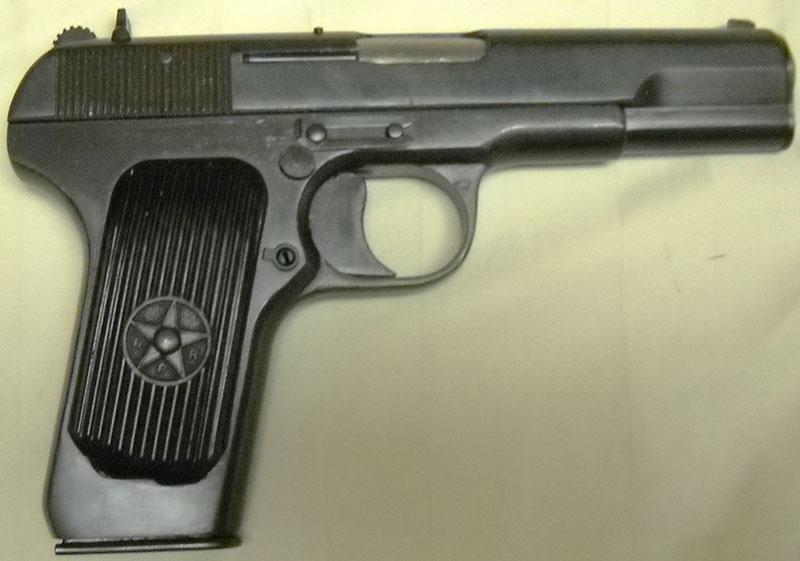
(Note the very badly broken right grip panel. I'll have to track down a replacement one of these days.)
Here is a Tokarev. This one is actually a foreign-made copy, but we'll get into that later. For now, let's talk about the original Soviet model. Fedor Tokarev (1871-1968) was an armorer and engineer who, by 1930, had been working in small arms development since around the turn of the century.
One interesting thing to note about Tokarev is that he was an officer of the Tsar's army—his first position of significant responsibility was as Master Armorer to the 12th Don Cossack Regiment, from his native Rostov-on-Don region—and yet was so well-regarded that he survived the Revolution with his career trajectory (to say nothing of his neck) intact. According to Ezell's Handguns of the World, he was so popular with the workers at the arms factory where he worked at the time of the Revolution, in Sestroretsk, that they made him their technical director in spite of his Tsarist history—this at a time when men were being killed for far less.
As a result, instead of dying or being forced into obscurity, Tokarev went on to serve a stint as a senior engineer at Izhevsk (Russia's and the Soviet Union's other great arsenal), and then on to Tula. By that point he was in his late fifties and could lay claim to some significant inventions, among them an improved version of the Maxim machine gun used in Russian military aircraft and an early submachine gun; but his most famous works were still ahead of him.
At the end of the 1920s, the Red Army had been experimenting in a fairly desultory manner with self-loading pistols for around ten years, but never got around to adopting one. In 1929, the Artillery Committee (essentially the Red Army's equivalent of the Ordnance Board) issued a request for a new round of pistols to test. The specification was fairly broad. It had to be a self-loading pistol and not a revolver; it had to be usable with one hand (so not a machine pistol, which were really small SMGs); and it had to be chambered for the 7.63×25mm Mauser cartridge.
The specification of the Mauser cartridge was not a random whim on the Council's part; it reflected a long-standing love affair that Russian Army officers, and their Bolshevik replacements, shared with the Mauser C/96 "broomhandle" pistol. Before the Revolution, many Tsarist officers bought C/96es with their own money rather than carry the standard-issue Nagant revolver. During the Revolution, many of those pistols were stolen confiscated by the revolutionaries; many more had been captured from Germans and Turks during the Great War, and were then looted liberated from arsenals.
Such was the Soviet love for the Mauser that one of the newly organized Red Army's early foreign purchases of arms, following the Civil War, was a large number of additional Mauser pistols bought from the recovering munitions industry of Weimar Germany. These new purchases were of the slightly downsized, shorter-barreled Model 1921 variant of the C/96, which became so closely identified with the Bolshevik regime that they are still called "Bolo" Mausers today. Here's one:
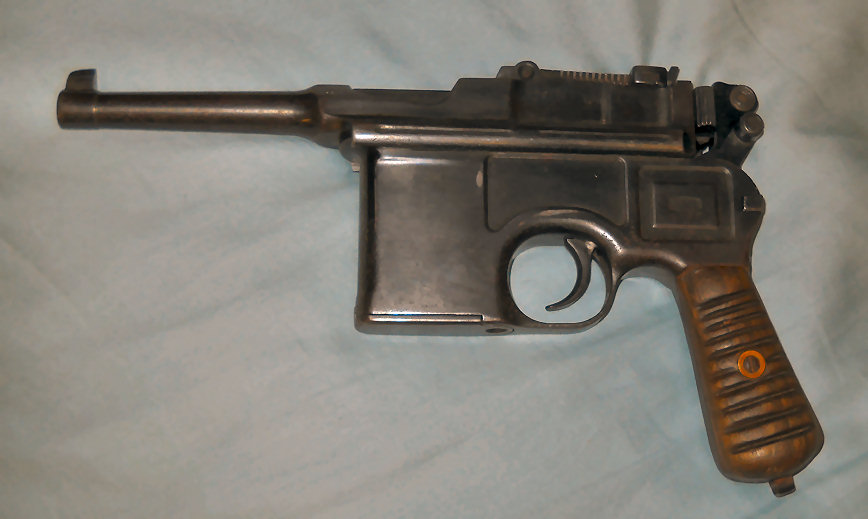
As such, and after some unproductive messing around with 7.65mm Browning (.32 ACP) designs in the '20s, the Red Army's commanders decided that the new pistol should use the well-known Mauser cartridge.
Or, well... sort of. That was the original intent, but in firearms design as in so many other creative endeavors, the original intent is often not what ends up happening. Somewhere along the line, someone realized that if they tweaked the loading of the Mauser cartridge just a little bit, the result would be substantially more powerful. The resulting cartridge, officially dubbed the "Model 1930 7,62mm Pistol Cartridge", looks virtually identical to its Mauser parent, but fires a very slightly lighter bullet at a somewhat higher velocity, delivering significantly more energy (ca. 560 foot-pounds(force) as opposed to around 400, if you're into that level of detail).
So, let's recap: the Artillery Committee put forth a recommendation that a new pistol be developed in 1929; the Revolutionary Military Council (early Soviet rough equivalent of the War Department) approved it in early 1930. In that same year, the new hot-rod variant of the old Mauser cartridge was developed, approved, and adopted in time for the people designing pistols for the aforementioned trial to use it. Within months, the candidates were being tested. One of those candidates was a new pistol submitted by our friend Comrade Tokarev of Tula, imaginatively designated the TT-30 (Tula, Tokarev, model of 1930).
Here is an example of how the famously elephantine and clumsy Soviet economic-technological system could, on occasion, outperform its ostensibly nimbler counterpart in the West: Tokarev's pistol was ordered in large numbers for troop trials in the first week of 1931, and adopted and put into general production by summer. Contrast that with, for instance, the almost eternal faff that was the U.S. armory process leading ultimately to the M1 Garand. When the Red Army decided to stop screwing around, it got things done in a hurry.
Mind you, it achieved part of that timeliness by utilizing what we might now think of as the Microsoft system, whereby you beta test the product by shipping it. The TT-30's original design was not optimized for mass production—there hadn't been time—and a package of design changes to simplify production followed in 1933, with the equally imaginative designation TT-33. This (and this is more what we tend to expect from the Soviet system) did not go into production until 1936.
The speed with which Tokarev was able to develop the TT pistol owed much to the fact that, like many firearms designers (and not just Soviet ones), he followed the Lobachevsky principle: "Plagiarize, only be sure always to call it, please, research." Let us consider, for a moment, the profile of Tokarev's pistol.
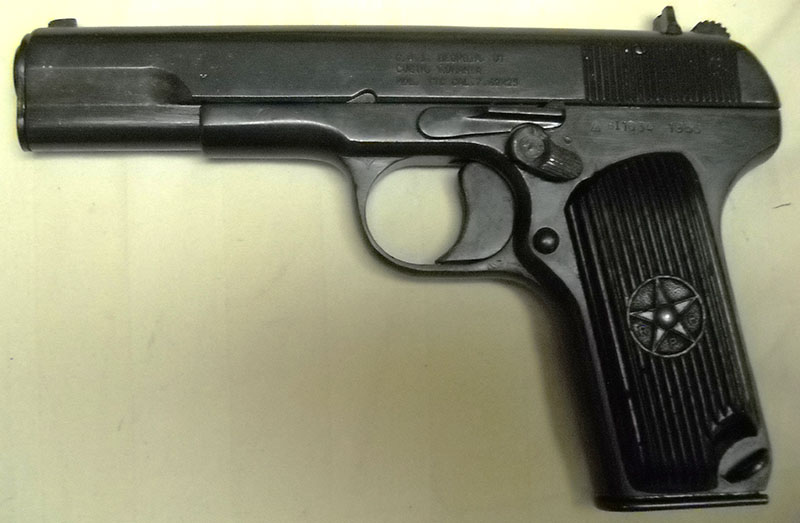
Does anything about that shape seem familiar? It probably should, if you've been keeping up with Gun of the Week right along:
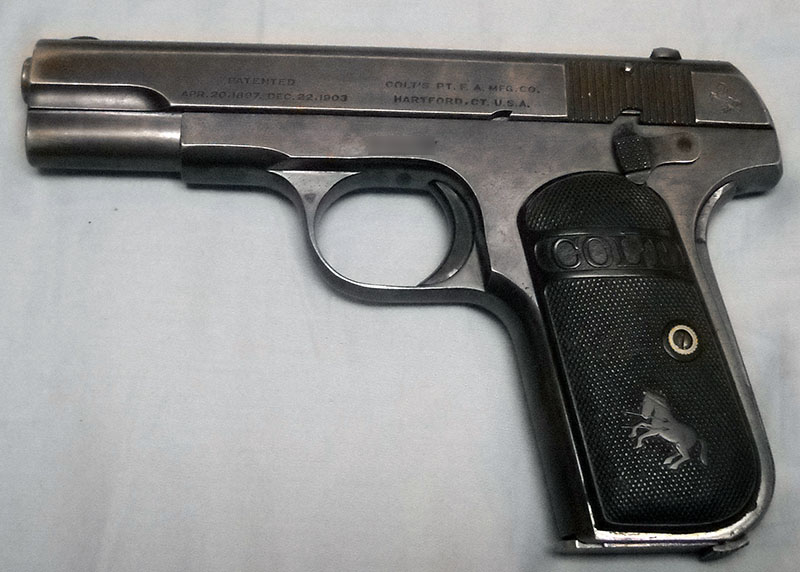
Mind you, the TT isn't based directly on the Colt 1903 Pocket Hammerless. Rather, its shape is derived from the slightly differently proportioned, larger-scale European brother of that gun, the FN Model 1903—but I think you can see the family resemblance.
However, don't be fooled by appearances! Mechanically, the TT is not a copy of the FN or Colt 1903. Those are simple blowback actions, they would be in no way suitable for use with a cartridge as energetic as 7.62x25mm. On the inside, the TT operates on a completely different principle...
... the principle of the M1911. Yes, that's right, Tokarev copied two different John Browning pistols in one when he developed the TT. Inside that scaled-up M1903 shape lies a tilting-barrel short-recoil system with a swinging barrel link, just like you'll find inside an M1911 if you can get it apart. The TT's takedown even has the same step where you have to remove the barrel bushing, albeit without the M1911's irritating recoil spring plunger to deal with. No, the TT's recoil spring is irritating in a whole different way. We'll get to that in a minute.
Keep in mind, this was not outright theft in a legal sense, even if Soviet industrial law had given a damn about such things (which it did not). Browning's patents on the 1903 and 1911 guns had expired by 1930 (as, alas, had Browning himself), and that is after all the point of patents: to preserve technical information about useful inventions so that all may benefit from it after such time as the legal protections afforded its creator have run their course. And it's a pretty clever synthesis, involving a few interesting innovations Tokarev came up with in his own right. We'll see more about those presently as well.
The TT-33 was in general production, as we've seen, from 1936. They were mostly issued to officers at first, noncoms being required to content themselves with the old Nagant. The plan may have been to phase the Nagant out by the early 1940s in favor of Tokarevs all around, but we'll never know, because in 1941, to borrow a phrase from Othais over at C&Rsenal, war were declared. The German invasion of the USSR changed many plans involving arms procurement in the Red Army, and one of them was that the Nagant stayed firmly in production until the end of the war, turned out in huge numbers right alongside its intended replacement.
The Tokarev pistol would remain the Red Army's principal sidearm until 1951, when changes to Soviet infantry doctrine led to its being considered too bulky and heavy for a front-line role. It was accordingly replaced with the much smaller Makarov (officially PM, Pistolet Makarova), which was basically a clone of the Walther PP chambered for a new 9x18mm cartridge. Production continued until 1952, then ceased—in the Soviet Union. Like many Soviet arms, however (consider the SKS, the TT was also produced under various designations in many of the other countries of the Communist bloc. In some of them, it remains in production today!
Which brings us to our actual example today. The pistol pictured above is not, technically speaking, a TT-33; it's a TTC, so called because it's a Tula-Tokarev pistol made at the Romanian state arsenal in the town of Cugir.
Other guises in which one may find Comrade Tokarev's signature design include the M48 (a Hungarian version rebarreled in 9mm Parabellum) and its export version the M58, which is rather charmingly known as the Tokagypt because they were made for the Egyptian police; the North Korean Type 68; Poland's wz. 33; and the Vietnamese K54, an updated variant of which, the K14-VN, just entered service with that country's army within the last few years.
Of special note, also, is the M57 family, which is made by the Serbian firm of Zastava (formerly a state arsenal of Yugoslavia, which is where they got the designs). The M57 itself is a straightforward TT-33 clone that is still in production—if you are so inclined, you can buy a brand new one here in the US today for not very much money. Zastava also sells a 9mm Parabellum version as the M70A.
I had an M57 for a while, a couple of years ago, but traded it for an Ortgies .32 which I thought was more interesting. I figured when the time was right, I'd track down an older one that has curio & relic status, which is ultimately where the TTC came from.
(One of these days, I'd like to track down an Izhevsk-made Soviet one, to go with my Izhevsk Nagant and Mosin-Nagant carbine, but they seem to be fairly rare—which is not that surprising, I suppose, since they came primarily from Tula.)
A design detail of note that has implications for American collectors is that the original TT-33, and many of its clones, did not have a manual safety. The single-action hammer had a half-cock notch, and... that was it. The Soviet doctrine of the time was that if you didn't want to shoot yourself with your pistol, then be more careful. And while I have to admit this philosophy appeals to me somewhat, the ATF takes a rather longer view. As such, unmodified TTs aren't legal for import into the US, and importers wishing to bring them in have to fit them with aftermarket safeties. These, let us say, vary widely in quality.
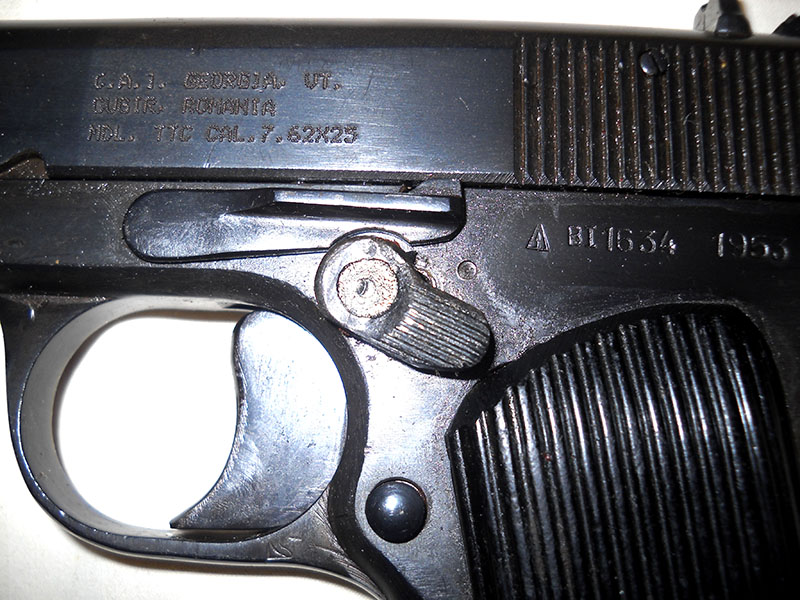
This is the one on my TTC. It's not the worst job I've ever seen, but it clearly isn't an original part. Seems to work all right, though. Also visible in this shot are the importer's markings (Century was in "Arms International" mode when they did this one, evidently, although the box it came in is marked "International Arms") and the original ones as well. I think that triangular marking before the serial number is the Cugir arsenal mark, but I'm not certain.
One thing I like about Eastern Bloc military arms is that a lot of their arsenals had the habit of marking the year of manufacture right on the gun, which removes ambiguity. In this particular case, this pistol appears to be vintage 1953.
The only other marking on this one is a repetition of the serial number on top of the slide. I paid an extra $10 to get one with matching numbers, because what the hell, $10. (Also, I'm not going to bother blurring the serial number, because the hell with it, on a 64-year-old Romanian Army pistol?)
Let's talk disassembly. The takedown on the TT-33 and its fraternal socialist comrades is pretty straightforward—more so, I have to say, than it is for either of the Browning pistols it's largely based on—but it does have a couple of irritating quirks. First, it has a very promising slide release lever-cum-takedown pin, like a Browning Hi-Power, which you can see above the safety in the photo above. (Note that whoever added the safety for CAI had to notch the lever slightly to accommodate it.)
But, on the other side...
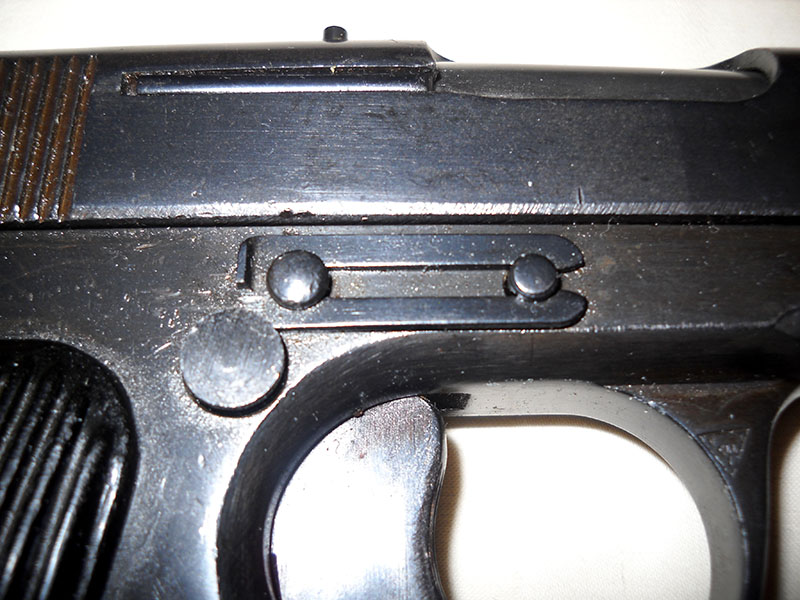
... Tokarev saw fit to secure said pin with this little spring clip, I guess because either it didn't occur to him how to get it to secure itself (like the Hi-Power's would, a few years later), or he didn't trust the manufacturing technology he had available to get the tolerances close enough for that to work, or something. Whatever the reason, it's here, and it means despite the promising appearance, you can't take the TT-33 down with your bare hands unless you have very much stronger thumbnails than I have.
It's tricky to get at that little bastard, I'll tell you now, and though it's tempting to use a screwdriver or something, you will slip and you will mar the finish if you do that. I used a spent 7.62mm Nagant case, because I had one handy, and it did the job decently well. Fortunately, you don't have to take it all the way off, just disengage it from the base of the takedown pin.
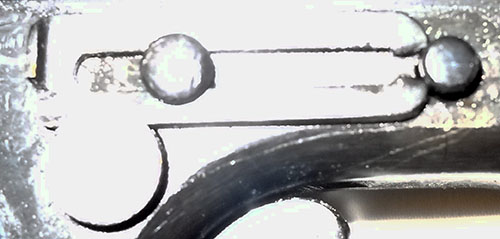
Like so. Apologies for the slightly surrealistic flash action in that photo.
Once the clip is disengaged, you can turn the pistol over, take up a little bit of the spring tension on the slide, and work the pin out, just like on a 1911 or a Hi-Power (or a CZ 75 or, well, any number of other pistols designed by someone with a 1991 or Hi-Power lying on a nearby table).
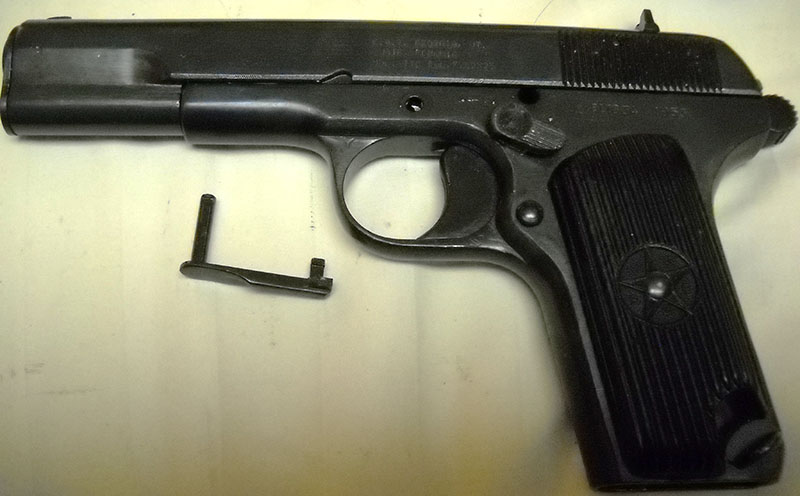
The reason why you have to take up a little bit of the spring tension will become apparent in a moment.
Now that the pin is out, the slide will come off the front in the usual manner, and if you're not careful you will discover the other Fun Bonus Feature of Comrade Tokarev's design in an abrupt and startling manner.
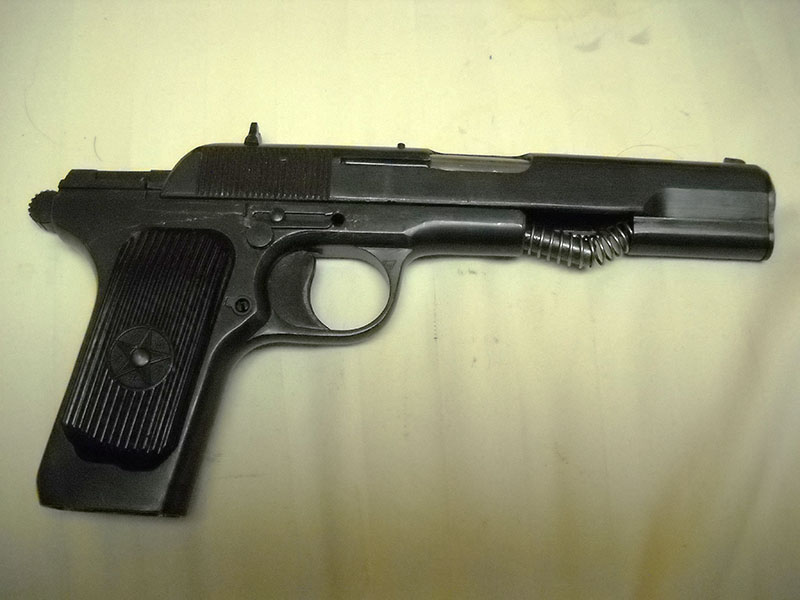
Note how the recoil spring is already trying to be a problem. The guide rod isn't long enough to control it properly when the slide is off the frame like that, and if not carefully managed, it will bulge out of there and/or kink all over the place and/or just come flying out and smack you in the thumb and make you say a bad word. I got lucky this time and managed to corral it into a photographable state...

... but once I took the slide the rest of the way off it instantly boinged out to its full length in an annoyingly exuberant manner. You would think it doesn't know it's supposed to be a dour Communist.
Anyway, once you've got it apart, everything looks very familiar.
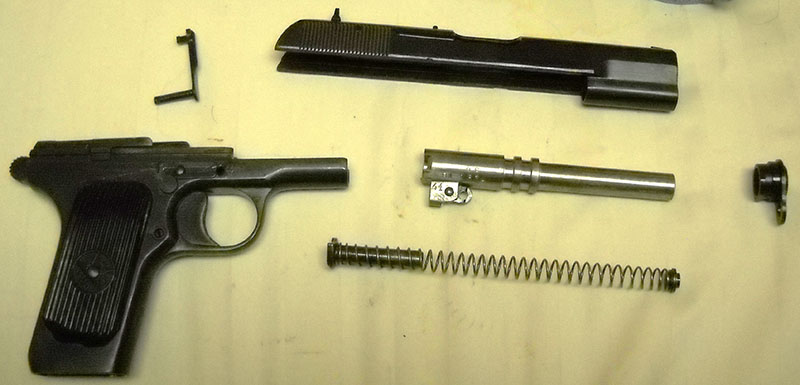
Yup, that's a Browning tilting-barrel system, all right. Complete with a hinged barrel link, just like on a 1911.
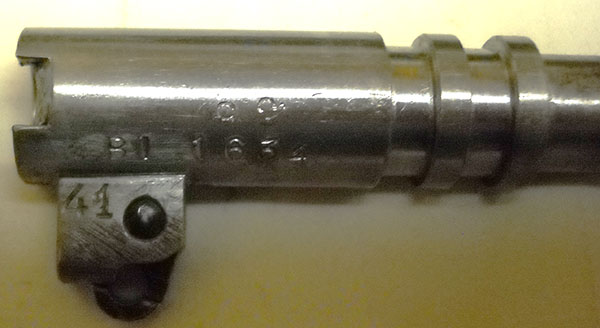
That's why you have to take up a little of the tension to get the pin out, by the way—it goes through the barrel link to hold the barrel in place, and if the slide is all the way forward, there's enough tension on the pin to make it really hard to get out.
Note also, in this photo, the locking lugs on the barrel. They don't actually need to go all the way around it like that, this isn't a rotating barrel system, and indeed in the original TT-30 design they didn't; but they don't interfere with anything if they do go all the way around, and the barrel is easier to manufacture if they do, so that was one of the revisions made for what became the TT-33 spec. It makes no functional difference, just makes the part slightly easier to machine.
Matching numbers in here too!

Here's a look up inside the slide. Nothing surprising in here, except maybe that the locking lug channels look unexpectedly shallow. Probably a trick of the light.
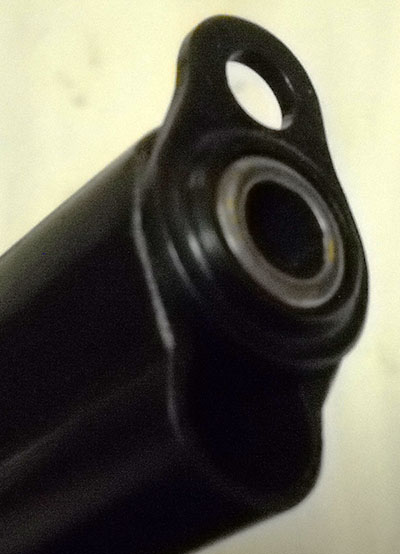
Here's that M1911-style barrel bushing, except the slide comes off without removing it first; you only have to take it off to get the barrel out, which means you don't have to fool around with it with the spring still in place. Which is nice! It's not threaded, there's a keyway in it that requires a 180° rotation to remove.
All in all, a pretty conventional Browning action, but Tokarev did have a couple of tricks up his sleeve. Here's the gun's party piece:
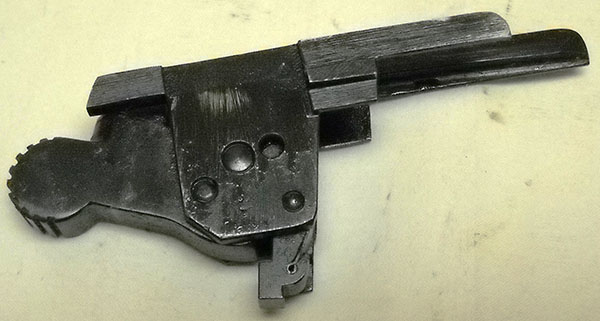
The hammer and associated lockwork is a separate module, it just drops into the frame (and drops out just as easily when the slide is taken off). As with the takedown pin clip, I'm not sure what made Tokarev think of this—maybe he figured the hammer mechanism would be particularly prone to breakage for some reason, and so decided to make it as easy to replace as possible. It would certainly be that; if you had a second hammer group module, it'd take all of two seconds to replace. Stripping the pistol and putting it back together again would take considerably longer than the repair itself.
Particularly because reassembly is, I must say, infuriatingly complicated by that stupid recoil spring. Seriously, it's like trying to put shaving cream back in the can. You have to compress the spring quite firmly to fit its end plate back where it goes, in front of the barrel link (and make sure you keep the barrel link swung down in the process), and at every point in the process it wants to kink and bulge out sideways, or pop out of place and waggle uselessly around, forcing you to restart the whole operation. Once you finally get it crammed into position, you have to hold it there, up against the underside of the barrel, while you finagle the slide back onto the frame, and you can't relax your vigil over it for an instant until it's safely tucked away again. I suppose Tokarev figured if the guide rod was longer, it would interfere with full compression, but it could be a bit longer than it is. Or telescoping, or something.
Apart from that supremely annoying little quirk, it's mechanically a pretty simple, straightforward action for a locked breech, and it's very strong—plenty strong enough to handle the souped-up Soviet evolution of the Mauser cartridge it was designed around.
Speaking of ammunition: Though not developed specifically for or used exclusively in Tokarev's pistol (Soviet submachine guns of the period, such as the famous PPSh, used it), the 7.62×25mm Model 1930 pistol cartridge is best-known for its use in same, and so almost universally labeled "7.62mm Tokarev" nowadays (in much the same way that 7.62x38mmR is always called "7.62mm Nagant" and Soviet 9x18mm is 9mm Makarov). Weirdly, neither 7.63mm Mauser nor its 7.62mm Soviet descendant actually uses a bullet of the size specified in its name. The Mauser round's nominal caliber is 7.86 mm (.309"), while the Soviet bullet clocks in at a slightly larger 7.88 mm (.310")!
(This last is probably because Russian gunmakers traditionally measured their bore calibers relative to the lands in the rifling rather than the grooves, so the bullets in Russian-designed cartridges are always a little bigger than Western ones of the same nominal caliber. 9mm Makarov bullets, for instance, are actually about nine and a quarter millimeters in diameter, because they have to span to the grooves of a bore whose lands are 9mm apart. This is why they should never be used in a Western 9mm barrel, which is 9mm apart at its widest.)
What that closeness in actual size means in practice is that there's little difficulty using either projectile in either bore, and the case geometries are basically identical. That's good if you've got a gun chambered for the Russian cartridge and a lot of old Mauser ammunition to use up (assuming the Mauser stuff can work the action), but going the other way can—as we have seen in other, similar cases—lead to significant problems. It means it's possible to load and fire the Soviet ammunition in old Mausers—and a lot of those are so elderly now that they have all they can do to handle their own ammo, let alone a significantly hotter Russian derivative.
Anyway, that's neither here nor there, except as yet another example of the downside of increasing the power of a commonplace cartridge without changing the dimensions appreciably.
As regards the Tokarev cartridge's power: it's fairly potent, but you will occasionally see wild stories online or in the press to the effect that it's some kind of magic ammo that ignores body armor, or that all 7.62×25mm ammunition is steel-core armor-piercing, or some such nonsense. Neither of these things is true.
The "ignores body armor" thing is simply a function of the fact that it's a relatively-small-diameter bullet with a respectable amount of muzzle energy, and so can penetrate some types of soft body armor... about as well as any other similar pistol cartridge, such as .357 Magnum, or the "+P" variant of 9mm Parabellum. (That's NIJ Type IIA, for those of you keeping score at home.) This was indeed unusually powerful for a handgun cartridge in 1930, but it's not so Earth-shaking now, relatively speaking.
The other rumor is even sillier. It's true that the Soviets did manufacture steel-core 7.62×25mm ammunition during World War II, mainly for use in the PPSh. It was incendiary, to boot! However, A, that was a long time ago and B, that ammunition would be illegal to import into the United States in two different ways, if any still exists. Nowadays the hype seems to be because some ex-Soviet and modern Russian Tokarev ammunition is steel-jacketed, but like conventional copper ones, those jackets are very thin (more like heavy foil), and the bullets themselves are still mostly lead. They are in no way armor-piercing. If they were—once again—they wouldn't be legal for import.
The sad thing is that it's not just laypeople buying into this nonsense. You will occasionally see shooting ranges, run by people who ought to know better, which ban Tokarevs because "all Tokarev ammo is AP" and the potential for ricochets or backstop penetrations is too great. Facepalm.
Anyway, Comrade Tokarev's pistol! Is good Soviet handgun. After the TT, Tokarev went on to develop the SVT-40, popularly nicknamed the Soviet Garand—a self-loading battle rifle in 7.62×54mmR, intended to replace the Mosin-Nagant as the primary rifle of the Workers' and Peasants' Red Army. Production was disrupted by Operation Barbarossa, and then the 7.62×39mm intermediate cartridge (and the SKS carbine to fire it) were developed during the war, so the SVT never went into the sort of general issue that was originally intended for it. However, there were still a lot of them, used primarily as sniper rifles or in what we would now call the Designated Marksman Rifle role (IIRC, the two roles are sort of conflated in Soviet/Russian doctrine anyway). It should not be confused with the SVD (Dragunov sniper rifle), which came later.
As for Fedor Tokarev himself, he was made a Hero of Socialist Labor (the USSR's highest technical/cultural honor) for his contributions to firearms technology and lived to the ripe old age of 96, dying in 1968. As with most of the greats in his field, his designs have outlived him; as previously noted, the Vietnamese Army only recently adopted a Tokarev derivative as a new sidearm, and TT-alikes are still produced in both China and the former Yugoslavia (and evidently, based on information that turned up in the comments of a previous GotW, Pakistan).
--G.